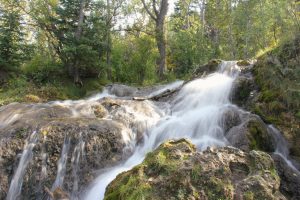

Gravel Mine Approval Threatens Big Hill Springs
August 3, 2023
- •
- •
- •
This important, unique, and ecologically sensitive ecosystem is one of the core attractions for the aptly named Big Hill Springs Provincial Park. Hosting a quarter of a million visitors annually, the park’s proximity to major urban centres like Cochrane, Calgary, and Airdrie affords locals an accessible opportunity to enjoy breathtaking views of waterfalls, creeks, and the surrounding forests close to home. Big Hill Springs also provides essential ecosystem services, including the provision of clean freshwater to Big Hill Creek and the Bow River.
Just 800 metres northwest from the provincial park and above the aquifer supplying Big Hill Springs, Mountain Ash Limited Partnership (MALP) recently received a Water Act approval from Alberta Environment and Protected Areas (AEPA) to develop its Summit Project, a sand and gravel mine which the company intends to operate for the next three to four decades.
Current plans promise to keep mining at a minimum to one metre above the underlying water table. MALP’s hydrological report states that this precaution will protect groundwater resources, but hydrogeologist and geochemist Dr. Jon Fennell notes the company’s assurances are inconsistent with current literature. Similar projects have raised the water table, exposed aquifers to oxygen, and enhanced weathering processes, ultimately impacting water quality. As put by Dr. Fennell:
“The removal of this essential filter will increase the risk of mobilizing fine particles, harmful trace elements… and other contaminants like spilled fuels or process chemicals, into the local groundwater”.
This possibility has led other proposed aggregate mining operations to be denied, as was the case recently when Red Deer County Council rejected a mine’s expansion application after lead and aluminum contaminated a neighbouring property’s well and water supply.
Alberta Wilderness Association was notified of AEPA’s decision on July 25, 2023, after submitting an initial statement of concern regarding the project back in January 2021.
Along with the concerns regarding Big Hill Springs itself, the mine will result in the removal of 15 waterbodies and disrupt habitat used by at least five provincially sensitive species observed within the project area, including the great blue heron, sora, least flycatcher, Eastern kingbird, and barn swallow (federally listed as threatened under Canada’s Species at Risk Act).
In response to AEPA’s decision, AWA submitted a notice of appeal on July 27, 2023, requesting the Environmental Appeals Board to rescind approval to MALP’s Water Act Application. MALP’s pit is just one of many recently approved aggregate mines. Having been in limbo for a few years, a slew of projects were suddenly approved immediately following the conclusion of the 2023 provincial election.
Fennel notes in his assessment of the project that a buffer of 1.6 kilometres around Big Hill Springs and the provincial park, accompanied by restricting extraction depths to four metres above the water table, would be “a responsible and sustainable response” to protect the environment while permitting aggregate development.
Evidence shows that Alberta struggles to properly regulate existing aggregate mines. Since 2008, the Auditor General of Alberta has found in every consecutive report that AEPA (or its precursors) “does not do enough to protect Albertans from risks” associated with the industry.
On July 29, the Environmental Appeals Board notified AWA and other appellants that it will begin addressing its submissions. AEPA will submit all the information used to arrive at their approval decision to the Environmental Appeals Board for review by October 23*.
AWA would like to see AEPA’s decision to approve MALP’s Water Act application rescinded by the Environmental Appeals Board. Kennedy Halvorson, AWA Conservation Specialist, states that:
“Aggregate resources such as gravel and sand are abundant in the province. There should be no reason that Albertans should have to tolerate extraction so close to beloved provincial parks or important water systems, risking the possibility of irreparable damage to ecological marvels like Big Hill Springs.”
For more information, please contact:
Kennedy Halvorson (cs1@abwild.ca)
403-283-2025
*Correction: An earlier version of this release stated AEPA needed to submit the requested information by August 8. This date was actually when they were required to respond to the Board regarding their timeline for submitting the information.


